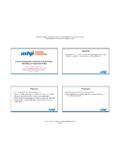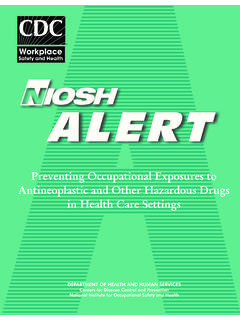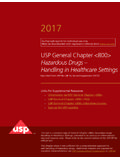Transcription of <800> HAZARDOUS DRUGS—HANDLING IN …
1 <800> HAZARDOUS DRUGS HANDLING IN. HEALTHCARE SETTINGS. (Chapter to become official July 1, 2018.). 1. INTRODUCTION AND SCOPE. This chapter describes practice and quality standards for handling HAZARDOUS drugs (HDs) to promote patient safety, worker safety, and environmental protection. Handling HDs includes, but is not limited to, the receipt, storage, compounding, dispensing, administration, and disposal of sterile and nonsterile products and preparations. This chapter applies to all healthcare personnel who handle HD preparations and all entities that store, prepare, transport, or administer HDs ( , pharmacies, hospitals and other healthcare institutions, patient treatment clinics, physicians' practice facilities, or veterinarians' offices). Personnel who may potentially be exposed to HDs include, but are not limited to: pharmacists, pharmacy technicians, nurses, physicians, physician assistants, home healthcare workers, veterinarians, and veterinary technicians.
2 Entities that handle HDs must incorporate the standards in this chapter into their occupational safety plan. The entity's health and safety management system must, at a minimum, include: A list of HDs Facility and engineering controls Competent personnel Safe work practices Proper use of appropriate Personal Protective Equipment (PPE). Policies for HD waste segregation and disposal The chapter is organized into the following main sections: 1. Introduction and Scope 2. List of HAZARDOUS Drugs 3. Types of Exposure 4. Responsibilities of Personnel Handling HAZARDOUS Drugs 5. Facilities and Engineering Controls 6. Environmental Quality and Control 7. Personal Protective Equipment 8. Hazard Communication Program 9. Personnel Training 10. Receiving 11. Labeling, Packaging, Transport, and Disposal 12. Dispensing Final Dosage Forms 13.
3 Compounding 14. Administering 15. Deactivating, Decontaminating, Cleaning, and Disinfecting 16. Spill Control 17. Documentation and Standard Operating Procedures Feb 2016 / USP Compounding Compendium Physical Tests / <800> HAZARDOUS Drugs 285. Copyright (c) 2016 The United States Pharmacopeial Convention. All rights reserved. Accessed from by Becky Burgess (apecmpg3z) on Thu Feb 04 09:35:55 EST 2016. 18. Medical Surveillance Glossary Appendices Appendix 1: Acronyms Appendix 2: Examples of Designs for HAZARDOUS drug Compounding Areas Appendix 3: Types of Biological Safety Cabinets References 2. LIST OF HAZARDOUS DRUGS. The National Institute for Occupational Safety and Health (NIOSH) maintains a list of antineoplastic and other HDs used in healthcare. An entity must maintain a list of HDs, which must include any items on the current NIOSH list that the entity handles.
4 The entity's list must be reviewed at least every 12 months. Whenever a new agent or dosage form is used, it should be reviewed against the entity's list. The NIOSH list of antineoplastic and other HDs provides the criteria used to identify HDs. These criteria must be used to identify HDs that enter the market after the most recent version of the NIOSH list, or that the entity handles as an investigational drug . If the information available on a drug is deemed insufficient to make an informed decision, consider the drug HAZARDOUS until more information is available. Box 1: Containment Requirements Drugs on the NIOSH list that must follow the requirements in this chapter include: Any HD API. Any antineoplastic requiring HD manipulation Drugs on the NIOSH list that do not have to follow all the containment requirements of this chapter if an assessment of risk is performed and implemented include: Final dosage forms of compounded HD preparations and conventionally manufactured HD products, including antineoplastic dosage forms that do not require any further manipulation other than counting or repackaging (unless required by the manufacturer).
5 For dosage forms of other HDs on the NIOSH list, the entity may perform an assessment of risk to determine alternative containment strategies and/work practices Some dosage forms of drugs defined as HAZARDOUS may not pose a significant risk of direct occupational exposure because of their dosage formulation ( , tablets or capsules solid, intact medications that are administered to patients without modifying the formulation). However, dust from tablets and capsules may present a risk of exposure by skin contact and/or inhalation. An assessment of risk may be performed for these dosage forms to determine alternative containment strategies and/or work practices. If an assessment of risk is not performed, all HDs must be handled with all containment strategies defined in this chapter. Feb 2016 / USP Compounding Compendium Physical Tests / <800> HAZARDOUS Drugs 285.
6 Copyright (c) 2016 The United States Pharmacopeial Convention. All rights reserved. Accessed from by Becky Burgess (apecmpg3z) on Thu Feb 04 09:35:55 EST 2016. The assessment of risk must, at a minimum, consider the following: Type of HD ( , antineoplastic, non-antineoplastic, reproductive risk only). Dosage form Risk of exposure Packaging Manipulation If an assessment of risk approach is taken, the entity must document what alternative containment strategies and/or work practices are being employed for specific dosage forms to minimize occupational exposure. If used, the assessment of risk must be reviewed at least every 12 months and the review documented. 3. TYPES OF EXPOSURE. Routes of unintentional entry of HDs into the body include dermal and mucosal absorption, inhalation, injection, and ingestion ( , contaminated foodstuffs, spills, or mouth contact with contaminated hands).
7 Containers of HDs have been shown to be contaminated upon receipt. Both clinical and nonclinical personnel may be exposed to HDs when they handle HDs or touch contaminated surfaces. Table 1 lists examples of potential routes of exposure based on activity. Table 1. Examples of Potential Opportunities of Exposure Based on Activity Activity Potential Opportunity of Exposure Receipt Contacting HD residues present on drug containers, individual dosage units, outer containers, work surfaces, or floors Dispensing Counting or repackaging tablets and capsules Compounding and other manipulations Crushing or splitting tablets or opening capsules Pouring oral or topical liquids from one container to another Weighing or mixing components Constituting or reconstituting powdered or lyophilized HDs Withdrawing or diluting injectable HDs from parenteral containers Expelling air or HDs from syringes Contacting HD residue present on PPE or other garments Deactivating, decontaminating, cleaning.
8 And disinfecting areas contaminated with or suspected to be contaminated with HDs Maintenance activities for potentially contaminated equipment and devices Administration Generating aerosols during administration of HDs by various routes ( , injection, irrigation, oral, inhalation, or topical application). Performing certain specialized procedures ( , intraoperative intraperitoneal injection or bladder instillation). Priming an IV administration set Patient-care activities Feb 2016 / USP Compounding Compendium Physical Tests / <800> HAZARDOUS Drugs 285. Copyright (c) 2016 The United States Pharmacopeial Convention. All rights reserved. Accessed from by Becky Burgess (apecmpg3z) on Thu Feb 04 09:35:55 EST 2016. Handling body fluids ( , urine, feces, sweat, or vomit) or body-fluid-contaminated clothing, dressings, linens, and other materials Spills Spill generation, management, and disposal Transport Moving HDs within a healthcare setting Waste Collection and disposal of HAZARDOUS waste and trace contaminated waste 4.
9 RESPONSIBILITIES OF PERSONNEL HANDLING HAZARDOUS DRUGS. Each entity must have a designated person who is qualified and trained to be responsible for developing and implementing appropriate procedures; overseeing entity compliance with this chapter and other applicable laws, regulations, and standards;. ensuring competency of personnel; and ensuring environmental control of the storage and compounding areas. The designated person must thoroughly understand the rationale for risk-prevention policies, risks to themselves and others, risks of noncompliance that may compromise safety, and the responsibility to report potentially HAZARDOUS situations to the management team. The designated person must also be responsible for the oversight of monitoring the facility and maintaining reports of testing/sampling performed in facilities, and acting on the results.
10 All personnel who handle HDs are responsible for understanding the fundamental practices and precautions and for continually evaluating these procedures and the quality of final HDs to prevent harm to patients, minimize exposure to personnel, and minimize contamination of the work and patient-care environment. 5. FACILITIES AND ENGINEERING CONTROLS. HDs must be handled under conditions that promote patient safety, worker safety, and environmental protection. Signs designating the hazard must be prominently displayed before the entrance to the HD handling areas. Access to areas where HDs are handled must be restricted to authorized personnel to protect persons not involved in HD. handling. HD handling areas must be located away from breakrooms and refreshment areas for personnel, patients, or visitors to reduce risk of exposure.






